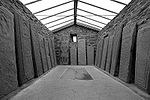
Kilmartin Stones
Encyclopedia

Kilmartin
Kilmartin is a small village in Argyll and Bute, western Scotland. It is best known as the centre of Kilmartin Glen, an area with one of the richest concentrations of prehistoric monuments and historical sites in Scotland. It contains over 350 monuments within a 6 mile radius.-Kilmartin Parish...
, Argyll
Argyll
Argyll , archaically Argyle , is a region of western Scotland corresponding with most of the part of ancient Dál Riata that was located on the island of Great Britain, and in a historical context can be used to mean the entire western coast between the Mull of Kintyre and Cape Wrath...
, Scotland
Scotland
Scotland is a country that is part of the United Kingdom. Occupying the northern third of the island of Great Britain, it shares a border with England to the south and is bounded by the North Sea to the east, the Atlantic Ocean to the north and west, and the North Channel and Irish Sea to the...
, about 30 km due south of Oban
Oban
Oban Oban Oban ( is a resort town within the Argyll and Bute council area of Scotland. It has a total resident population of 8,120. Despite its small size, it is the largest town between Helensburgh and Fort William and during the tourist season the town can be crowded by up to 25,000 people. Oban...
(about 46 km by road). The earliest stones date back to the thirteenth or fourteenth centuries, with the most recent ones dated 1707 and 1712.
Description
Originally, the stones would have been laid flat on the ground to cover a grave. After the ReformationScottish Reformation
The Scottish Reformation was Scotland's formal break with the Papacy in 1560, and the events surrounding this. It was part of the wider European Protestant Reformation; and in Scotland's case culminated ecclesiastically in the re-establishment of the church along Reformed lines, and politically in...
, however, many of the stones were moved, and in 1956 they were moved inside a shelter to protect them from the weather. The symbolism of the motifs carved onto the slabs is the subject of much discussion and speculation. Many feature swords or claymore
Claymore
The term claymore refers to the Scottish variant of the late medieval longsword, two-handed swords with a cross hilt, of which the guards were in use during the 15th and 16th centuries.-Terminology:...
s, some alone, others with surrounding designs of twining or interlaced foliage
Celtic knot
Celtic knots are a variety of knots and stylized graphical representations of knots used for decoration, used extensively in the Celtic style of Insular art. These knots are most known for their adaptation for use in the ornamentation of Christian monuments and manuscripts, such as the 8th-century...
. Several depict armed men. Other motifs include crosses, animals and shears; a comb appears with shears on one stone. It has been suggested that several of the slabs may commemorate Knights Templar
Knights Templar
The Poor Fellow-Soldiers of Christ and of the Temple of Solomon , commonly known as the Knights Templar, the Order of the Temple or simply as Templars, were among the most famous of the Western Christian military orders...
but this theory is unproven.
The nearby landscape
Kilmartin GlenKilmartin Glen
Kilmartin Glen is an area in Argyll not far from Kintyre, which has one of the most important concentrations of Neolithic and Bronze Age remains in Scotland. The glen is located between Oban and Lochgilphead, surrounding the village of Kilmartin....
is the richest prehistoric landscape in Scotland. Within an area not much over 6 miles (9.7 km) long a huge diversity of standing stone
Standing stone
Standing stones, orthostats, liths, or more commonly megaliths are solitary stones set vertically in the ground and come in many different varieties....
s, stone circle
Stone circle
A stone circle is a monument of standing stones arranged in a circle. Such monuments have been constructed across the world throughout history for many different reasons....
s, carved rocks
Cup and ring mark
Cup and ring marks or cup marks are a form of prehistoric art found mainly in Atlantic Europe and Mediterranean Europe although similar forms are also found throughout the world including Mexico, Brazil, Greece, and India, where...
and ancient tombs can be found. It also has what is believed to be the only 'linear cemetery' in the country, a series of chambered cairn
Chambered cairn
A chambered cairn is a burial monument, usually constructed during the Neolithic, consisting of a cairn of stones inside which a sizeable chamber was constructed. Some chambered cairns are also passage-graves....
s (burial mounds) laid out in a straight line right down the bottom of the glen
Glen
A glen is a valley, typically one that is long, deep, and often glacially U-shaped; or one with a watercourse running through such a valley. Whittow defines it as a "Scottish term for a deep valley in the Highlands" that is "narrower than a strath."...
. The oldest of these is believed to be 6,000 years old.
The reason for such a concentration of these ancient monuments in one small area of the Scottish Highlands
Scottish Highlands
The Highlands is an historic region of Scotland. The area is sometimes referred to as the "Scottish Highlands". It was culturally distinguishable from the Lowlands from the later Middle Ages into the modern period, when Lowland Scots replaced Scottish Gaelic throughout most of the Lowlands...
is unknown.

